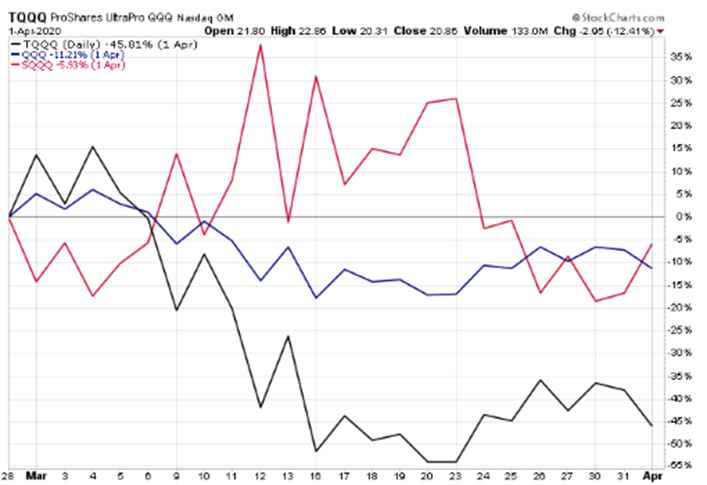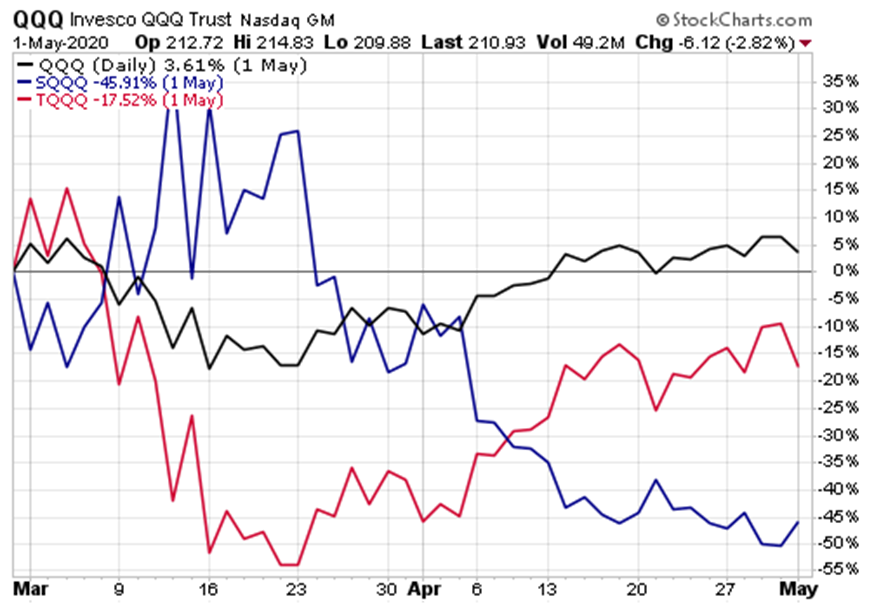Leveraged ETFs proved to be popular with investors over the past month, particularly those that offer amplified exposure to tech names that sold off at the beginning of the week.
As tech stocks fell throughout the week, money flowed into the ProShares UltraPro QQQ ETF (TQQQ), which offers 300% exposure to the Nasdaq 100. On the flip side, the ProShares UltraPro Short QQQ ETF (SQQQ), which offers the opposite exposure of TQQQ, or -300% of the performance of the Nasdaq 100, saw net outflows in the week to 1 October.
TickerNameNet flowsTQQQProShares UltraPro QQQ ETF$1.2bnSQQQProShares UltraPro Short QQQ ETF$-94mQQQInvesco QQQ Trust$-1.7bn
Source: FactSet
On a somewhat contradictory note, the Invesco QQQ Trust (QQQ) also saw outflows for the week. However, TQQQ’s inflows show that speculative investors seem to be banking on a recovery in the Nasdaq 100.
Short-term play
Leveraged and inverse ETFs make sense as a short-term play – with extra emphasis on “short term” if they are offering 3x exposures. If an investor has a strong conviction that the market will move up or down in the very near future – meaning days, not weeks – a leveraged ETF could work well.
However, investors should be aware of the risk of leveraged strategies if they are held over long time periods. These ETFs are designed to provide a multiple of daily index performance. That said, the pattern of returns can have a significant impact on the long-term returns of a leveraged ETF, which is why it is not recommended to hold these for longer periods of time.
As an example, let us consider the trailing one-year performance of these three ETFs.

Over the trailing year, TQQQ has provided a little over 3x the exposure of QQQ. However, SQQQ has fallen by just over twice the amount of QQQ’s gain.
Volatility’s effect
For segments of the market that tend to be more volatile and prone to big swings, leveraged ETFs are more likely to be off the mark when used over longer time periods.
This is especially true in periods of market stress, such as we saw last spring.

In March 2020, all three of these ETFs notched negative returns. QQQ fell by 11.2% for the month, meaning that, at least on the surface, inverse exposure should have resulted in a gain. However, SQQQ fell by 5.9% during this time frame. And TQQQ was down by over four times as much.
Longer time frames mean more risk
The example is reinforced when we extend the time frame to include April 2020.

Over this time period, QQQ had recovered from its decline, gaining 3.6%.
However, in spite of the base exposure’s positive return, both TQQQ and SQQQ were significantly negative. TQQQ had fallen by 17.5%, meaning that instead of providing 3x to the base index, it was actually 5x inverse performance. And SQQQ was providing over 12x inverse performance to QQQ.
That is because of the daily reset feature of the ETFs, which delivers 3x or -3x the returns of the relevant index on any given day, rather than the week or the month. A highly volatile market can complicate matters even more.
Expensive exposure
Along with the risk of performance not being in line with expectations, leveraged ETFs also command a higher management fee to accommodate the expense of leveraging and actively rebalancing their funds. While cost is unlikely to be a factor in the selection process for leveraged ETFs, it is still a factor that contributes to the erosion of performance over time.
Relative to its vanilla counterpart, TQQQ is nearly five times as expensive with a total expense ratio (TER) of 0.95%.
SQQQ has the same expense ratio as TQQQ. Though the fund holds over $1.7bn assets under management, its lower trading volume means the spread is higher than that of QQQ and TQQQ.
Buyer beware
Investors who purchase leveraged ETFs should be fully aware that if these funds are held for longer than a few days, they might not be getting the exposure they expect—both directionally and in magnitude.
In spite of the risks, these types of funds retain their appeal. At a basic level, leveraged funds provide the potential for higher gains if one correctly predicts the way the market will move over the next few days.
But as with anything in the investing world, this promise of higher reward also comes with a higher level of risk. If the market moves against you (and sometimes even if it does not), investors can get burned.
This story was originally published onETF.com


